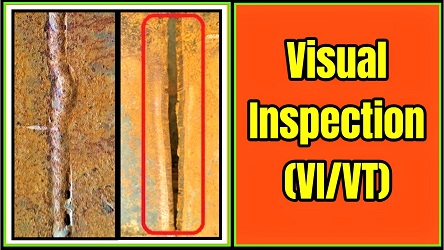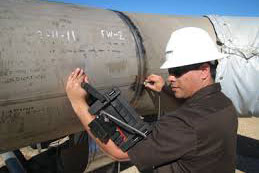A Comprehensive Overview to Welding Evaluation: Understanding Standards, Techniques, and Best Practices for Quality Control

Welding inspection plays a pivotal duty in ensuring the architectural stability and safety of bonded components, requiring a detailed understanding of sector requirements such as those established by AWS and ASME. Different examination strategies, including ultrasonic and aesthetic screening, are used to find prospective problems that can endanger high quality. In addition, executing ideal practices can considerably improve operational integrity and foster trust fund among customers. As we discover these essential aspects, it comes to be noticeable that the effects of welding evaluation extend much past compliance, inviting a closer assessment of just how these processes form market requirements and techniques.
Importance of Welding Evaluation
Welding evaluation plays a vital duty in guaranteeing the integrity and safety and security of welded structures. It is a necessary process that validates that welds comply with predefined specs, which is important in numerous industries, consisting of building and construction, automotive, and aerospace. By performing complete assessments, potential problems such as splits, insufficient blend, and porosity can be identified early, preventing devastating failings that can lead to crashes or costly repair work.
The relevance of welding assessment extends beyond simple compliance with regulations; it likewise promotes depend on with stakeholders. Customers and regulatory bodies anticipate guarantee that the frameworks they count on are built to endure functional anxieties. Reliable welding inspection techniques add to long-lasting longevity and performance of the structures, inevitably leading to minimized upkeep costs.
In addition, welding assessment advertises a society of top quality within organizations, motivating adherence to ideal practices and continual improvement. By incorporating examination procedures right into the welding process, firms can improve their credibility and establish themselves as leaders in quality control. Finally, the value of welding assessment lies in its ability to guard lives, make certain structural dependability, and copyright industry standards, making it a crucial aspect of welding operations.
Trick Industry Standards
Making certain conformity with crucial sector standards is crucial for keeping the top quality and safety and security of bonded frameworks. Numerous companies establish these standards to promote finest methods in welding and assessment. Among the most recognized are the American Welding Society (AWS) and the American Culture of Mechanical Engineers (ASME), which provide comprehensive guidelines and specifications for welding procedures and assessment requirements.
AWS criteria, such as AWS D1.1 for architectural welding, summary needs for products, layout, and testing to make certain the stability of welds. ASME codes, including ASME Area IX, control the credentials of welders and welding procedures, guaranteeing consistent top quality in commercial applications. Worldwide, the ISO 3834 conventional highlights top quality demands for combination welding, giving a framework for companies to show conformity with worldwide finest methods.
Conformity with these requirements not just boosts the integrity of welded frameworks but also mitigates risks connected with structural failings. Additionally, adherence to market standards is commonly a requirement for regulative authorizations and can substantially influence project specifications. Inevitably, understanding and implementing these key standards are important for effective welding assessment and quality control.
Inspection Techniques Introduction
Efficient welding examination depends on a range of techniques made to assess the quality and integrity of welds. These strategies can be broadly classified into non-destructive and devastating testing (NDT) methods. Non-destructive screening methods, which are commonly favored in the sector, permit the examination of welds without jeopardizing the honesty of the material.
Amongst one of the most commonly used NDT techniques are visual examination, ultrasonic screening, radiographic screening, and magnetic bit testing. Aesthetic examination is frequently the very first step in the analysis process, making it possible for inspectors to determine surface blemishes and analyze weld bead accounts. Ultrasonic screening utilizes high-frequency audio waves to detect internal imperfections and gauge the thickness of welds. Radiographic screening entails using X-ray or gamma-ray imaging to expose internal issues, while magnetic bit testing works for detecting surface and near-surface suspensions in ferromagnetic materials.
Each strategy has its very own advantages and limitations, making it essential for inspectors to select one of the most ideal method based upon the certain demands of the task, the materials involved, and the criticality of the welds being evaluated. This careful choice maintains and guarantees thorough assessments safety and security and top quality standards in welding operations.

Common Issues and Their Implications
A comprehensive understanding of usual issues in welds is important for keeping structural integrity and security in welded constructions. Welding defects can significantly endanger the mechanical properties of the joint, resulting in failures that might endanger both personnel and devices.
Usual issues include porosity, which materializes as small gas pockets entraped in the weld steel, weakening the general structure. Splitting is another prevalent issue, often resulting from read what he said quick air conditioning or improper joint why not check here style, resulting in stress focus that can lead to tragic failures. Incomplete blend takes place when the weld metal stops working to appropriately bond with the base product, creating weak factors that may cause splitting up under tons.
Other notable defects consist of damaging, where the weld bead erodes the base metal, and slag inclusions, which can hinder the weld's stamina. Each of these flaws has details implications; as an example, porosity can minimize ductility, while splitting straight impacts tensile strength. Recognizing and understanding these flaws throughout evaluation is important for implementing corrective measures and guaranteeing conformity with market standards, inevitably protecting the architectural honesty of welded settings up.
Best Practices for Quality Control
Executing finest techniques for quality control in welding processes is vital for attaining ideal results and minimizing problems. One important technique is the facility of clear welding procedures that follow market requirements and requirements. These procedures need to consist of detailed guidelines pertaining to product option, joint prep work, and welding methods to make sure uniformity and quality.
Routine training and qualification of welding workers are additionally vital. Knowledgeable welders who comprehend the relevance of top quality guarantee are most likely to produce sound welds. In addition, carrying out a robust assessment program, including both aesthetic and non-destructive screening (NDT), can help recognize flaws early in the procedure, permitting for prompt restorative activities.
Documentation plays a key duty in quality control. Preserving accurate documents of welding repairs, parameters, and assessments ensures traceability and liability. Additionally, employing sophisticated technologies such as automated welding machines can boost accuracy and minimize the capacity for click now human error - Welding Inspection Gilbert Arizona.
Lastly, cultivating a culture of quality within the company urges workers to focus on quality in their job. By adhering to these finest practices, organizations can enhance the stability of their welding procedures, eventually leading to boosted product top quality and reduced costs linked with rework and repair work.

Verdict
Finally, welding evaluation plays an important duty in guaranteeing the honesty and safety of bonded structures. Adherence to essential market requirements, such as those established by AWS and ASME, is important for effective quality guarantee. Employing various assessment methods allows for the recognition of common issues, thereby reducing possible risks. By carrying out best practices, organizations can boost reliability, reduce maintenance costs, and grow depend on among customers, eventually contributing to effective welding operations.
In addition, welding evaluation advertises a society of quality within companies, encouraging adherence to ideal methods and continuous renovation. In conclusion, the significance of welding assessment exists in its capability to guard lives, make sure architectural integrity, and promote market requirements, making it an essential element of welding procedures.
Among the most recognized are the American Welding Culture (AWS) and the American Culture of Mechanical Designers (ASME), which give thorough guidelines and requirements for welding procedures and inspection standards.
Ultimately, understanding and implementing these crucial requirements are essential for effective welding examination and quality guarantee.
Reliable welding evaluation relies on a range of methods made to examine the top quality and honesty of welds. - Welding Inspection Gilbert Arizona